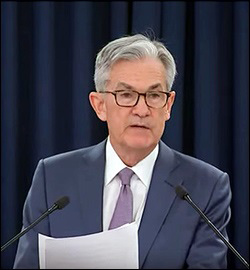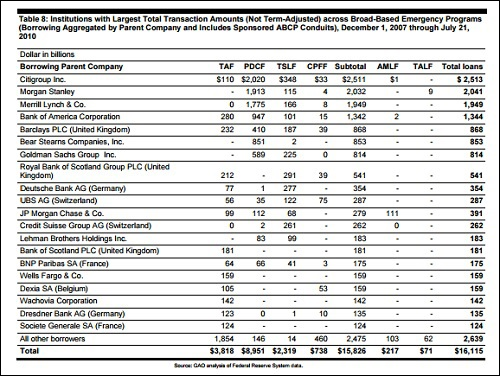By Pam Martens and Russ Martens: May 26, 2020 ~
If you are an individual and you want to buy stocks on margin at a brokerage firm in the U.S., under Federal Reserve Board Regulation T the brokerage firm can lend you a maximum of 50 percent of the total initial purchase price. Not all stocks are eligible for margin. There are also maintenance margin requirements imposed by the industry, stock exchanges and the brokerage house itself if the stock value drops after the initial purchase, which could trigger a margin call and subject you to having to deposit more cash or securities under penalty of having your account liquidated at a loss.)
Regulation T grew out of the stock market crash of 1929 and ensuing economic collapse known as the Great Depression. The crash was correctly blamed on the lack of regulation of Wall Street firms which were allowing customers to borrow as much as 90 percent in their stock margin accounts. Following three years of stock market hearings before the Senate Banking Committee of that era, which revealed an unprecedented level of corruption and self-dealing on Wall Street, Congress enacted sweeping legislation. In addition to the Glass-Steagall Act (Banking Act of 1933) which banned Wall Street’s stock trading and underwriting houses from owning deposit-taking banks, the Securities Exchange Act of 1934 (15 U.S.C. 78) gave authority to the Federal Reserve Board to set margin policy and required the following at that time:
“For the purpose of preventing the excessive use of credit for the purchase or carrying of securities, the Board of Governors of the Federal Reserve System shall, prior to October 1, 1934, and from time to time thereafter, prescribe rules and regulations with respect to the amount of credit that may be initially extended and subsequently maintained on any security (other than an exempted security or a security futures product). For the initial extension of credit, such rules and regulations shall be based upon the following standard: An amount not greater than whichever is the higher of — (1) 55 per centum of the current market price of the security, or (2) 100 per centum of the lowest market price of the security during the preceding thirty-six calendar months, but not more than 75 per centum of the current market price.”
This would seem to make clear that there was Congressional intent to permanently prevent stock market bubbles that would crash and leave the U.S. economy in ruins as a result. Since 1974 the Fed has kept its Regulation T margin requirement at 50 percent.
Unfortunately, once Wall Street was allowed to become a major funder of political campaigns for members of Congress, the reins on Wall Street have been eliminated one by one. The Glass-Steagall Act was repealed in 1999, leading to the behemoth trading houses that exist today on Wall Street which also own the largest deposit-taking banks in the country. Because these deposit-taking banks are federally-insured and backstopped by the taxpayer, the Federal Reserve began during the last financial crisis in 2007 to 2010 to interpret its job to be bailing out both the insured banks and their uninsured stock trading houses.
The Fed is taking the same attitude today, having now set up the same alphabet soup of lending facilities as it did from 2007 to 2010.
The largest bailout facility that the Fed used in the 2008 financial crisis, and is using again today, is the Primary Dealer Credit Facility (PDCF). The last time around, it made $8.95 trillion cumulatively in revolving loans to the trading houses on Wall Street, which it calls its “primary dealers.” We know this from the eventual audit that was performed by the Government Accountability Office (GAO) after the Fed had stonewalled the public from getting details in its multi-year court battle, which it eventually lost.
Despite the fact that the stock market was in the midst of crashing in September of 2008, the GAO audit revealed that beginning on September 14, 2008, the Fed expanded its PDCF eligible collateral to include “noninvestment grade securities and equities,” i.e., junk bonds and stocks.
But instead of setting prudent margin requirements for the loans being made against stocks, the Fed allowed the trading houses to borrow close to the full amount of their collateral. We know this because the Fed was forced to release the details of these loans following media lawsuits and an Appellate Court order.
For example, line 352 on the Fed’s Excel spreadsheet for its PDCF loans shows that on September 19, 2008 Morgan Stanley was allowed to receive a loan of $35.3 billion against collateral that totaled only $37.841 billion or 93 percent margin — like during the heydays leading up to the crash of 1929. The collateral that Morgan Stanley posted for the loan included $16.99 billion in stocks; $14.7 billion in corporate bonds; $4 billion in municipal notes/bonds; $489 million in mortgage-backed securities and CMOs; and $1.458 billion in ABS (asset-backed securities).
This loan was not an aberration. Multiple trading houses borrowed from the Fed on similar terms using stock as collateral as shown on the Fed’s Excel spreadsheet linked above.
At the time, Morgan Stanley was predominantly a trading house. Its federally-insured banking units were modest compared to the largest banks in the country. Since the creation of the Federal Reserve in 1913, its role has been to support the U.S. economy by serving as the lender-of-last-resort to deposit-taking commercial banks in a time of crisis so that they can continue to make loans to businesses and consumers to keep the economy growing. The mandate of the Fed has never been to prop up stock trading houses on Wall Street.
Notwithstanding that, two of the three largest recipients of the PDCF loans in the last crisis were Morgan Stanley, which received a cumulative total of $1.9 trillion in loans, and Merrill Lynch, a brokerage firm and investment bank, which received $1.775 trillion in revolving loans under the PDCF. (See GAO chart below.)
The largest recipient of PDCF loans in the crisis was Citigroup, which had turned itself into both a giant deposit-taking bank and a casino filled with derivatives and toxic subprime debt. Despite becoming insolvent, the Fed continued making loans to Citigroup as its stock price went to 99 cents. Citigroup received a total of $2.02 trillion in revolving loans under the PDCF.
There is every reason to believe that the same scenario is playing out today in the PDCF. The Fed is refusing to reveal the firms that are getting its PDCF loans and how much they are getting individually. The Fed has released a Term Sheet for the PDCF and it shows that the Fed is once again making loans against stock as collateral. Morgan Stanley’s loan under the PDCF that we reference above was made at a 2.25 percent interest rate. Today the Fed is making these preposterous loans at the rate of 0.25 percent.
The last time around the Fed’s PDCF loans were limited to overnight. Today they have been expanded to as long as 90 days.
The Wall Street cozy presidency of Bill Clinton not only repealed the Glass-Steagall Act but it also reinterpreted margin lending. The National Securities Markets Improvement Act of 1996 exempted the trading houses on Wall Street (broker dealers) from the Fed’s margin rules if the borrowing was “to finance its activities as a market maker or an underwriter.” The legislation did, however, add this: “Notwithstanding this exclusion, the [Federal Reserve] Board may impose such rules and regulations if it determines they are necessary or appropriate in the public interest or for the protection of investors.”
The facts on the ground this morning are that the U.S. has Great Depression level unemployment and a stock market soaring 600 points as of 10 a.m. on hopes of expanded Fed bailouts.
Where are the hearings in Congress? Where is the outrage?



